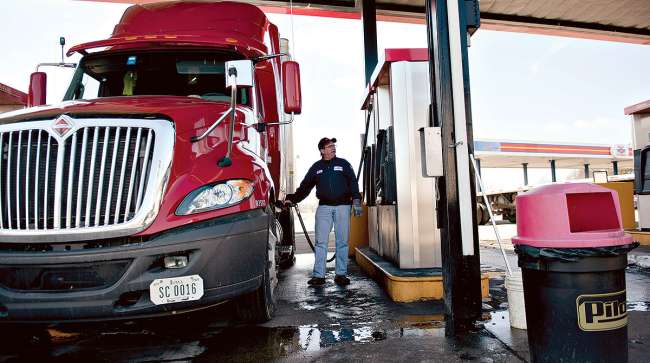Staff Reporter
Diesel Ticks Up 0.4¢ to $3.051 a Gallon

[Stay on top of transportation news: Get TTNews in your inbox.]
The U.S. average retail price of diesel rose by 0.4 cent to $3.051 a gallon, the Department of Energy reported Oct. 15, breaking a three-week decline. Trucking’s main fuel costs 34.3 cents less than it did a year ago, when it was $3.394, DOE said.
All regions saw the average price increase except New England, where the price dropped 0.5 cent to $3.042, and the Midwest, where it remained at $2.967 per gallon.
Diesel rose the most in the West Coast less California, where prices jumped 2.5 cents to $3.240 per gallon.
Gasoline fell 1.6 cents to $2.629. Gasoline declined in all regions except the West Coast, which saw an increase of 2.3 cents to $2.665 per gallon. Gasoline fell the most in the Lower Atlantic states, dropping 3.7 cents to $2.360 per gallon.
Oil prices remained relatively low, with West Texas Intermediate for November delivery 16 cents higher at $52.97 a barrel on the New York Mercantile Exchange (NYMEX) on Oct. 16. Brent crude for December settlement was 36 cents higher at $59.10 on the London-based ICE Futures Europe Exchange. The global benchmark settled at a premium of $5.97 to WTI for the same month.
Oil futures eased back to $53 a barrel. The industry-funded American Petroleum Institute reported a 10.5 million-barrel build in crude stocks, according to Bloomberg News.
Hopes for a resolution of key issues in the U.S.-China trade dispute are fading, souring prospects for a revival in energy demand, according to Bloomberg. Meanwhile, the International Monetary Fund cut its 2019 global growth forecast for a fifth time, Bloomberg said.
Denton Cinquegrana, chief oil analyst for the Oil Price Information Service, told Transport Topics that the U.S.-Chinese trade dispute is indeed souring demand for oil, keeping West Texas Intermediate in its usual “comfort zone” of between $53 and $55 per barrel.
Saudi Arabia, a major oil producer and exporter, also showed resiliency in its production after an attack on its Saudi Aramco refineries on Sept. 14, he said. The attacks were said to have been supported by Iran, Saudi Arabia’s chief rival in the Middle East.
But the Saudis responded well to the attack, and opened up spare capacity to maintain production, said Cinquegrana.
He added that despite the low price of oil, a major hurdle remains in 2019 and 2020 for diesel producers: the new regulations placed upon bunker fuel, the main fuel of large commercial ships.
The International Maritime Organization is making shippers use low-sulfur fuel as of Jan. 1, 2020. In 2016, the United Nations’ IMO directed the maritime industry to significantly drop sulfur content from 3.5% to 0.5% — seven times lower than it is now.
To meet the requirements of the new mandate, the majority of shipping companies will significantly increase the use of diesel. According to a 2017 survey of shipping companies from investment bank UBS, 74% said they will switch to diesel, while the rest either plan to install equipment to remove sulfur or convert their ships to liquefied natural gas.
“You are going to see a greater demand for diesel,” said Cinquegrana, warning of higher retail prices in the future.
Since diesel fuel is a major cost for carriers, some trucking business officials watch the cost of diesel on a daily basis.
“We watch (ultra-low sulfur diesel) trade live daily on the NYMEX and adjust our purchases based on market moves up or down,” said Brett Thompson, vice president of purchasing for Daseke Inc., the Addison, Texas-based parent company of numerous flatbed and heavy-specialized carriers. “We set up relationships with key fueling networks. We look at purchases outside of those key networks daily, and adjust.”

Plus, the diversity of Daseke’s truck fleet demands differing strategies for fuel, Thompson said in an email.
“When it comes to fuel efficiency there isn’t one size that fits all,” he told TT. “To maximize efficiency, we pay attention to idle fuel, out-of-route miles and our choices in tractor, trailer and tire specifications.”
Out-of-route miles can include deadheading, road closures, route changes or “driver convenience” — the miles a driver travels to take the unit to his or her home, Thompson said, but noted the effects of these conditions can be mitigated by slowing down or reducing idle.
“It’s a matter of coaching the driver,” Thompson told TT.
Daseke ranks No. 21 on the Transport Topics Top 100 list of the largest for-hire carriers in North America.
Want more news? Listen to today's daily briefing:




